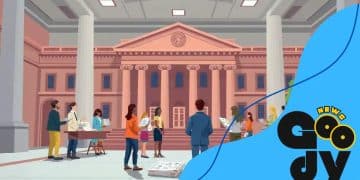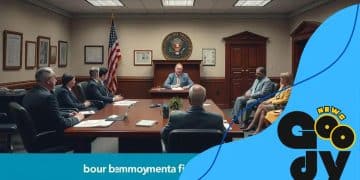Federal hiring freeze 2025 memo raises concerns

The federal hiring freeze impacts government agencies by restricting new hires. It also increases workloads for existing staff and creates challenges for job seekers.
The memo has sparked discussions about its effects on government employment. This will influence job opportunities and agency operations.
The federal hiring freeze 2025 memo has sparked discussions about its effects. Let’s dive into the details.
Overview of the federal hiring freeze
The federal hiring freeze is a significant policy that impacts government employment. It restricts the hiring of new employees across various government agencies.
This measure is typically enacted during periods of budgetary constraints or organizational restructuring. As a result, agencies must rely on existing employees.
These restrictions can affect how agencies function. The lack of new hires may lead to increased workloads for current employees and a decrease in public services.
What is the Federal Hiring Freeze?
A federal hiring freeze is a directive that restricts the hiring of new employees across various government agencies. This measure is typically enacted during periods of budgetary constraints.
When a hiring freeze is in place, agencies must rely on existing employees. They may also face challenges in addressing staffing shortages.
This situation can lead to lower employee morale as existing staff cope with additional responsibilities. It also makes it more challenging for candidates to land federal employment.
Consequences on Government Services
The implications of a hiring freeze are far-reaching. With essential roles left unfilled, public services can suffer.
Citizens may experience longer response times and reduced availability of services. This situation can lead to lower employee morale as existing staff cope with additional responsibilities.
It’s crucial to consider the impact on job seekers as well. Competition intensifies, making it more challenging for candidates to land federal employment.
Impacts on government agencies and employees

The impacts on government agencies and employees as a result of the federal hiring freeze are significant. This policy not only affects the hiring process but also the overall functioning of government departments.
When a hiring freeze is enforced, agencies encounter several challenges. There are often unfilled positions that lead to increased workloads for the remaining employees.
This can result in fatigue and lower morale. Additionally, employees may feel uncertain about their future within the organization.
Challenges Faced by Agencies
When a hiring freeze is enforced, agencies encounter several challenges. There are often unfilled positions that lead to increased workloads for the remaining employees.
This can result in fatigue and lower morale. Keeping operations running smoothly becomes a struggle as existing staff manages tasks beyond their usual scope.
Furthermore, the lack of new hires means fewer fresh perspectives and ideas. This stagnation can hinder innovation and growth within agencies.
Effects on Employee Morale
Alongside the workload, employees may feel uncertain about their future within the organization. Concerns about job security can lead to a tense work environment.
Furthermore, the lack of new hires means fewer fresh perspectives and ideas. This stagnation can hinder innovation and growth within agencies.
The ripple effects of the federal hiring freeze can create a cycle of challenges for government agencies. This impacts community service and agency effectiveness.
Impact on Service Delivery
Government agencies play a crucial role in providing services to the public. When staffing levels drop due to a hiring freeze, the quality and timeliness of those services can diminish.
For example, long processing times for permits or applications may become common. This can affect citizens’ trust in their government.
The ramifications extend beyond just employment levels. They also impact community service and agency effectiveness.
Potential consequences for job seekers
The potential consequences for job seekers due to the federal hiring freeze are significant. As positions cease to open up, many individuals may find themselves at a disadvantage.
When a hiring freeze is in effect, the number of available jobs drastically decreases. This leads to fewer chances for candidates to apply and secure positions.
The competition grows fierce as individuals from various backgrounds seek government roles. This disparity can lead many to reconsider their career paths.
Reduced Job Opportunities
When a hiring freeze is in effect, the number of available jobs drastically decreases. This leads to fewer chances for candidates to apply and secure positions.
Many job seekers may spend more time competing for a limited number of openings. This can be frustrating and disheartening.
The competition grows fierce as individuals from various backgrounds seek government roles. This can lead many to reconsider their career paths.
Alternative Career Paths
As the hiring freeze continues, job seekers often turn toward the private sector. Many begin to explore opportunities in businesses or non-profit organizations.
This shift can shape the future workforce. Talented individuals leave government positions for more promising alternatives.
Some job seekers may invest in additional training to enhance their credentials. This allows them to remain competitive in a shrinking job market.
Alternatives to address staffing needs
Finding alternatives to address staffing needs during a federal hiring freeze requires creativity and strategy. Government agencies are forced to explore new ways to maintain efficiency and service delivery.
One of the first steps agencies can take is maximizing the potential of their existing workforce. Cross-training employees can develop a versatile team.
Agencies can also outsource certain tasks or invest in technology. These solutions help agencies adapt and deliver services to the public effectively.
Utilizing Existing Staff Effectively
One of the first steps agencies can take is maximizing the potential of their existing workforce. Cross-training employees can develop a versatile team capable of handling multiple roles.
This flexibility helps to fill gaps created by unfilled positions. Agencies can also engage private contractors for specific projects.
Implementing technology solutions can also increase productivity without the need for additional hires.
Outsourcing and Partnerships
Outsourcing certain tasks or consulting with other organizations can provide immediate relief for staffing shortages. Agencies can engage private contractors for specific projects or form partnerships with non-profits.
By creating partnerships, agencies can share resources. This ensures that essential functions continue without interruption.
Implementing Technology Solutions
Another effective alternative is to invest in technology. Automating routine tasks can increase productivity without the need for additional hires.
Agencies can also consider remote work options where feasible. This approach can widen the potential employee pool.
This provides flexibility and adaptability. It helps attract candidates who prefer a better work-life balance.
Future expectations on hiring policies
The future expectations on hiring policies are evolving. This is due to the changing needs of government agencies and the job market.
Understanding these expectations can provide insights into how agencies will respond. The landscape will be shaped by economic realities.
The landscape of hiring policies will also be influenced by a commitment to diversity and technology. These factors will play a crucial role in attracting talent.
Adaptation to Economic Changes
As economic conditions fluctuate, hiring policies may need to adjust accordingly. For instance, during times of economic growth, agencies may lift hiring freezes.
Conversely, in times of budget cuts, we might see tighter controls and more freezes. This adaptation is essential for effective governance.
The landscape of hiring policies will be shaped by economic realities. This allows agencies to better respond to staffing challenges.
Focus on Diversity and Inclusion

Future hiring policies are expected to emphasize diversity and inclusion. Agencies will likely adopt strategies that aim to create a representative workforce.
This shift will help bring in varied perspectives. It can also improve decision-making within government bodies.
This commitment is crucial for attracting talent in a competitive environment, as it demonstrates a forward-thinking approach that prioritizes fairness and modern values.
Integration of Technology
Advancements in technology will also influence hiring practices. Agencies are expected to leverage digital recruitment tools to streamline their processes.
Automated systems can help reduce the time needed for resume evaluations. This makes the hiring process more efficient.
Remote work options may become standard, allowing agencies to access a broader talent pool. This provides flexibility in response to changing workforce needs.
FAQ – Frequently Asked Questions about Federal Hiring Freeze
What is a federal hiring freeze?
A federal hiring freeze is a policy that restricts hiring new employees in government agencies, usually due to budget constraints or restructuring.
How does the hiring freeze affect job seekers?
The hiring freeze leads to fewer job openings, increasing competition among candidates and making it harder to secure a position in the government.
What alternatives can agencies explore during a hiring freeze?
Agencies can optimize existing staff, consider outsourcing tasks, and implement technology solutions to manage workloads and maintain efficiency.
Are there future expectations for hiring policies?
Hiring policies are expected to adapt based on economic conditions, focusing more on diversity and leveraging technology for streamlined processes.





